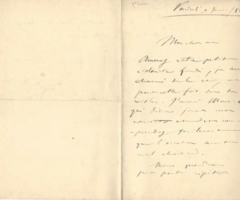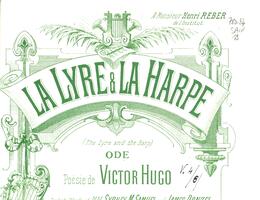La Lyre et la Harpe
Cantata for solo voices, chorus and orchestra, to a poem from Odes et Ballades.
“In a marvellous ode, La Lyre et la Harpe, Victor Hugo has brought Paganism and Christianity face to face; each speaks in its turn, and the poet, in the last stanza, appears to acknowledge that they are both right.” In these few words, Saint-Saëns encapsulates both the gist of Hugo’s poem and the driving force of his own piece: a dialogue in twelve stanzas alternating between the secular lyre and the Christian harp gives rise to a strongly contrasting duel between the representative of sensual, pagan pleasures, and that of the Christian ideal, of God’s power and love. This antithesis, which is even more pronounced than that inspired by Hugo’s lines, pervades all the musical components (melody, harmony and instrumentation) placed alternately by Saint-Saëns at the disposal of the lyre or the harp. This is very clear from the first two stanzas alone: while the Lyre, conveyed by a delicate, ethereal chorus and orchestra, soothes the slumber of the God Apollo (“Dors, ô fils d’Apollon”), the Harp, introduced by the spare solemn melody of the organ, exhorts mankind in the voice of the solo baritone to wake and look upon the woes of the world (“Éveille-toi jeune homme, enfant de la misère!”). This long musical conversation punctuated by highly contrasting passages subsides in an epilogue when the Poet, entering into the fray, states his preference for the virtues of synthesis and a happy medium (“Dire à l’écho du Pinde un hymne du Carmel”). Dedicated to Henri Reber, the composer and Saint-Saëns’ friend, this cantata was premiered on 28 August 1879, in England, at the Birmingham Festival, where Saint-Saëns himself conducted an enormous choir and orchestra numbering over five hundred performers.


